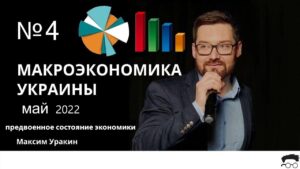
Ukraine’s GDP in 2022 will decrease by 30%, however, the unblocking of seaports would reduce the economic decline to 22-25%, Olena Bilan, chief economist at Dragon Capital, believes. The real gross domestic product (GDP) of Ukraine in the first quarter of 2022 fell by 15.1% compared to the first quarter of 2021 after growing by 6.1% in the fourth quarter of last year, the State Statistics Service published such a preliminary estimate.
The economy of Ukraine is gradually recovering from the level of the greatest fall in March thanks to the regions where there are no active hostilities, as a result, the decline in May this year (against the same month last year) slowed down to 35-40%, Deputy Governor of the National Bank of Ukraine Serhiy Nikolaychuk said.
The National Bank expects Ukraine’s GDP to fall by at least a third in 2022, Deputy Governor of the NBU Serhiy Nikolaychuk said during the presentation of the report on financial stability.
The National Bank of Ukraine (NBU) estimates Ukraine’s losses from destroyed housing, business and infrastructure due to Russian aggression at 50% of GDP in 2021, or $100 billion, according to a financial stability report published on the central bank’s website on Tuesday.
The real GDP of Ukraine will decrease by more than a third in 2022, inflation accelerated to 20% in the first half of the year, according to bankers surveyed by Interfax-Ukraine.
The deficit of Ukraine’s foreign trade in goods in January-April 2022 fell by almost 97.6% compared to the same period in 2021, to $29.6 million from $1.237 billion.
Consumer price growth in Ukraine in May 2022 slowed down to 2.7% from 3.1% in April and 4.5% in March, but exceeded 1.6% in February and 1.3% in January, the State Statistics Service said on Thursday.
The state budget deficit in January-May 2022 exceeded annual deficits of the previous two years, the National Bank of Ukraine (NBU) said in its June macroeconomic and monetary review.
Ukraine’s total state debt in April grew by 0.84% in U.S. dollars to $97.62 billion, in hryvnias – by 0.84% to UAH 2.855 trillion, according to data on the website of the Ministry of Finance.
Economic Monitoring’s Project Manager – PhD in Economics, Maksim Urakin

The construction of another plant began in the Bila Tserkva industrial park (Kyiv region), the launch is scheduled for November 1, UFuture founder Vasyl Khmelnytsky told Interfax-Ukraine.
“During the war, we felt a big request from Ukrainian manufacturers from the regions to relocate to the Bila Tserkva industrial park. They have an alternative – moving to the EU, but it is important for the economy to leave producers in the country: these are taxes, jobs and development. Today we’ve started the construction of a new modern facility for a plant on 4,000 sq m. The amount of investment will be approximately $2 million,” he said.
Khmelnytsky added that this project will be the company’s record for the speed of construction.
“Already on November 1, we will launch production there. Now we are negotiating with several applicants from Mykolaiv and Kharkiv,” Khmelnytsky said.
UFuture holding company of businessman Khmelnytsky, as part of a business strategy in 2022, planned to expand the number of production facilities in Bila Tserkva industrial park from five to 11. Earlier, in an interview with the Interfax-Ukraine agency, he said that 11,000 sq m of industrial premises will be built in this park for the relocation of enterprises, the estimated investment is $6.5 million. In general, the entrepreneur announced plans the construction of 30 factories in Bila Tserkva.

Fenerbahce lost at home to Dynamo Kyiv (1:2) in the second leg of the 2nd round of the 2022/23 Champions League qualification. The first game in Kyiv ended in a 0-0 draw, in the game in Turkey we had to play overtime.
The winner of this pair goes to the Austrian Sturm. The loser is waiting for the Czech club Slovacko already in the Europa League. The first game with the Austrian Sturm at Dynamo (Kyiv) will take place on August 2.

The Federal Reserve System (FRS) has raised the interest rate on federal funds (federal funds rate) by 75 basis points, now its range is 2.25-2.5% per annum, according to a communiqué of the Federal Committee for Operations on open market (FOMC) following the results of the July meeting.
The decision coincided with the forecasts of economists and market participants and was adopted unanimously by all 12 voting members of the FOMC. The Committee met in full force for the first time in recent years.
Thus, the Fed raised the rate by 75 bp. following the results of the second meeting in a row and noted that he expects to continue the course of tightening monetary policy, which will be expressed in an increase in rates and a decrease in the volume of assets on the balance sheet of the central bank.
The regulator’s management noted the weakening of production indicators and spending in the US economy, and at the same time pointed to a strong growth in the number of jobs in recent months, while maintaining low unemployment.
“Inflation remains elevated, reflecting the supply-demand imbalance caused by the pandemic, rising food and energy prices, and broader price pressures,” the document said.
The war in Ukraine creates “additional upward pressure on inflation and negatively affects global economic activity,” Fed officials said.
As previously reported, US consumer price growth accelerated to 9.1% in June from 8.6% in May, hitting a 40-year high.
“FOMC aims to achieve maximum employment and inflation at 2% in the long term,” – the message says.
“In evaluating the appropriateness of monetary policy, the FOMC will continue to monitor the impact of incoming information on the economic outlook. The Fed is ready to adjust its approach to monetary policy, if necessary, if risks arise that could hinder the achievement of FOMC goals,” the communiqué says. take into account a wide range of information, including data from the health sector, labor market conditions, inflationary pressures and inflation expectations, developments in financial markets, as well as international developments.”
American financial markets reacted moderately to the results of the Fed meeting, as they were largely taken into account in current quotes. The Dow Jones stock index by 21:16 Moscow time increased by 0.4%, while the Standard & Poor’s 500 rose by 1.44%, and the Nasdaq Composite – by 2.65%. The yield on 10-year US government bonds is still close to 2.77%.

SE NNEGC Energoatom is ready to put into operation all 15 power units of 4 Ukrainian nuclear power plants next winter, company president Petr Kotin said on Ukrainian radio on Wednesday.
“We are ready to launch all 15 power units from the Energoatom generation side,” Kotin said.
At the same time, he explained that the largest in Ukraine and occupied by Russian invaders, the Zaporozhye nuclear power plant, is currently operating at half capacity due to damage to power lines.
“Everything will depend on the end of hostilities. If we liberate the Zaporozhye nuclear power plant and resume the operation of the damaged lines, then we will be able to work with all six power units at the ZNPP,” the head of Energoatom said.
At the same time, according to him, the remaining nine power units in the territory controlled by Ukraine will be ready to operate at full capacity.
“We are optimistic about these events and the fact that we will pass the heating season,” the president of NAEK stressed.
As reported, Energoatom used the practice of operating 15 power units in January-February this year, which caused ambiguous comments from experts regarding the optimal loading of the energy system in terms of the structure of generating capacities.
However, in the upcoming heating season 2022-23. The launch of the maximum number of NPP power units can be facilitated by an increase in electricity exports to the EU countries by the end of 2022 to approximately 1,000 MW.

Agroholding MHP, the largest producer of chicken meat in Ukraine, in January-June 2022 reduced chicken production by 3% compared to the first half of 2021 – to 346.04 thousand tons, while its sales – by 12%, to 338.6 thousand tons, the holding company reported on the London Stock Exchange on Wednesday.
It is noted that in the second quarter of 2022, the agricultural holding, in the context of the Russian military invasion, reduced chicken production by 11% compared to March-June last year – to 170.4 thousand tons, and by 3% compared to the first quarter of 2022. At the same time, the volume of chicken meat sales in the second quarter of 2022 amounted to 140.6 thousand tons, which is 23% lower than the same period last year, but 1.6% higher than sales in the first quarter of this year.
According to the exchange message, in January-June 2022, chicken sales on the domestic market decreased by 6% compared to the first half of 2021 – to 134.7 thousand tons, while supplies to foreign markets – by 17%, to 157.9 thousand tons. At the same time, in the second quarter of 2022, chicken sales in Ukraine amounted to 67.9 thousand tons, decreasing by 6% compared to the second quarter of 2021, but increasing by 1.6% compared to the first quarter of 2022. In turn, chicken meat exports in the second quarter of 2022 fell by 37% by the second quarter of 2021, and by 23% by the first quarter of 2022, to 68.55 thousand tons.
Thus, the share of chicken exports in January-June of this year decreased by 4 percentage points (p.p.) against January-June 2021 to 52% from 56%, while in March-June 2022 this figure decreased to the same period last year by 11 percentage points – up to 48% from 59%.
In addition, MHP poultry farms in the EU in January-June 2022 produced 37.4 thousand tons of poultry meat, which is 5% more than in the first half of 2021, and in the second half of 2022 – 19.6 thousand tons (+ 1% compared to the same period in 2021).
The average price of chicken meat in January-June 2022 increased by 24% year-on-year, to $1.93/kg, while in March-June it increased by 22% compared to the same period last year, to $2.03/kg.
According to MHP, in the first half of this year, the agricultural holding increased sales of culinary products by 76% compared to the first half of last year – up to 6.97 thousand tons, including in the second quarter of 2022 it sold 4.1 thousand tons of these products ( +54% compared to the second quarter of 2021).
According to the report, the sale of processed meat products (including sausages) by the agricultural holding in January-June 2022 decreased by 48% compared to January-June 2021 – to 8.3 thousand tons, and in March-June 2022 – by 73 % compared to March-June last year, up to 2.3 thousand tons.
According to the results of the first half of the period, the sale of semi-finished meat products decreased by 14% – to 7.4 thousand tons, while according to the results of the second quarter – by 24%, to 3.42 thousand tons.
MHP specified that in January-June 2022, sales of sunflower oil decreased by 11% compared to January-June last year, while in March-June 2022 they increased by 38% compared to March-June 2021, to 48.5 thousand tons. tons. At the same time, sales of soybean oil in the first half of 2022 decreased by 15%, and in the second quarter increased by 23% compared to the same periods in 2021, to 19.5 thousand tons and 9.2 thousand tons, respectively.
“In 2022, the company should sow about 335 thousand hectares of land in the grain crops segment. The harvesting campaign for winter rapeseed and wheat is on schedule, of which 70% and 25% are harvested, respectively. The yield of all winter crops is expected to be good and in line with the company’s expectations with taking into account the weather conditions. Spring crops (corn, soybean and sunflower) are in good condition,” the agricultural holding stated in an exchange message. MHP is the largest chicken producer in Ukraine. It is also engaged in the production of cereals, sunflower oil, meat processing products. On the European market, MHP supplies chilled half-carcasses of chickens, which are processed, including at its enterprises in the Netherlands and Slovakia. In February 2019, the agricultural holding completed the acquisition of the Slovenian company Perutnina Ptuj.
MHP generated $393 million in net profit in 2021 against a net loss of $133 million in 2020, while its revenue grew by 25% to $2.37 billion.
The founder, majority shareholder and head of the board of MHP is Ukrainian businessman Yuriy Kosyuk.